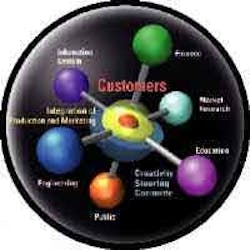Shaping the future of manufacturing
As part of its lean manufacturing initiative, Mazak has reorganized to eliminate time wasted communicating through a traditional hierarchy. According to the company, this improves production and lets it respond more quickly to customer needs.
The addition of a material-handling robot lets the Integrex e-bot Cell 720 provide up to 720 hr of automated production.
Mazak added multitasking capabilities to its Nexus line with the introduction of the QTN-350M turning center.
Although Mazak Corp., Florence, Ky., highlighted new products at its recent Touch the Future 2004 event, its focus was manufacturing for a global economy. The four-day summit, which drew approximately 1,700 participants, gave shops ideas for improving their lean initiatives, boosting productivity, and exploiting new technologies. According to Mazak President Brian Papke, companies that welcome such changes will be in a better position to increase market share and grow as economic conditions improve.
"Large and small manufacturing companies alike face an unrelenting customer focus to cut costs, improve production efficiency with minimum inventory, and not retreat a single inch on product quality," says Papke. "In the meantime, capital equipment continues to age. The overall result is a tangible hollowing-out of this country's manufacturing base. Even if the economic climate improves dramatically and customers begin spending again, is American manufacturing in a position to compete globally?"
As part of the program, Mazak detailed its $20 million investment in its own manufacturing operation, which has resulted in a lean-manufacturing system it calls Production on Demand — essentially, building machines to order and not to forecast. Since implementing the system, Mazak has significantly shortened leadtimes, eliminated waste, and reduced inventory levels.
The firm's four-pronged approach involves a common software platform for real-time communication across the factory floor, employee cross-training, new cellular layouts featuring Mazak multitasking and material-handling equipment, and a modular assembly system that exploits improvements in machine tool design. Mazak has proven out these concepts in several "cyber factories," where it has networked all machines and created databases that help Mazak predict changing end-user needs.
"The objective of Production on Demand grew out of the concept for the new family of Nexus machines," says Papke. "The design and production goals for Nexus were to produce machines with higher performance features that were more accurate, but still would be reasonable in price. The intent was to respond quickly to changing market conditions and product-design changes. Building to order on demand has resulted in significantly lower finished-goods inventory while realizing the goal of delivering Nexus machines in weeks instead of months."
These Nexus systems were among the 22 machines Mazak introduced at the event. The expanded Nexus family now includes the QTN-250MS and QTN-350M turning centers, both of which feature multitasking capabilities. The machines have integral spindle-motor technology on their main turning spindles for heavy-duty metal removal and high-speed cutting of aluminum and other nonferrous materials.
According to Mazak, the Nexus QTN-250MS transfers a workpiece between the first and second headstock to quickly complete machining operations. In addition, the workpiece can be automatically oriented in phase for smooth, continuous operation. The machine's single-step, 12-tool-position turret-indexing time of 0.2 sec/position minimizes idle time, which also increases productivity.
As for the QTN-350M, the machine lets shops turn, mill, drill, tap, and bore the same workpiece in a single setup. High-gain servo control makes acceleration/deceleration fast and virtually vibration-free. The machine's single-step 12-tool position turret indexing time is 0.25 sec/position.
Mazak also unveiled its first horizontal machining center in the Nexus line — the HCN-6000. Like other Nexus machines, it features integral spindle/motor technology (50 hp, 10,000-rpm maximum speed) with a 50-taper spindle. And its 19.69 19.69-in. pallets handle workpieces up to 35.43 in. in diameter and 39.37-in. high.
With a standard 43-tool magazine (60, 80, and 120-tool magazines are optional), the Nexus HCN-6000 tackles a range of horizontal machining tasks. Maximum tool length is 19.69 in., and maximum diameter is 4.92 in. (9.84 in. if the adjacent tool pockets are empty). A standard two-pallet changer holds a maximum load of 2,200 lb and changes positions in 9 sec.
Besides the Nexus line, Mazak showcased several other technological developments in both hardware and software. In particular, participants had the opportunity to see how Mazak weaves digital information together with new multitasking machine designs. These machines combine processes, eliminate fixturing, reduce tooling cost, eliminate in-process inventory, and accurately produce parts.
For instance, Mazak's new Integrex e-410H is a high-performance multitasking machine delivering turning, milling, drilling, tapping, and other operations in a single setup. The machine is now more efficient thanks to the addition of a material-handling robot. This configuration, called the Integrex e-bot Cell 720, delivers up to 720 hr of automated production — or 90 eight-hour shifts, nonstop.
The Integrex e-bot Cell 720 and the Mazatrol 640M Pro CNC make the Integrex e-410H even more of a standalone production center. The machine also features Mazak's e-Tower, which combines electronic-communication tools for integrated production-management functions such as work scheduling and monitoring of production and machine status.
